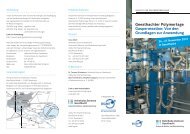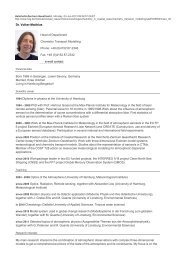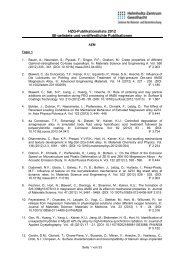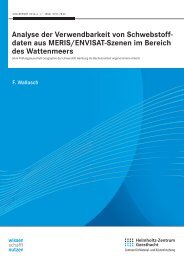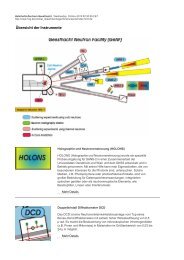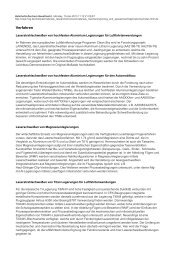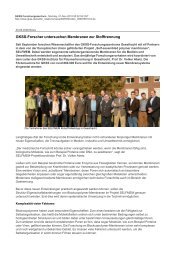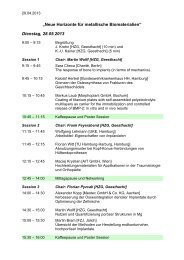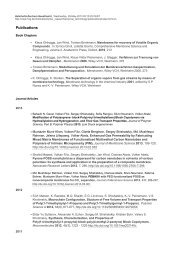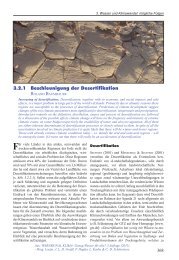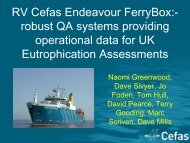Landfills and waste water treatment plants as sources of ... - GKSS
Landfills and waste water treatment plants as sources of ... - GKSS
Landfills and waste water treatment plants as sources of ... - GKSS
Create successful ePaper yourself
Turn your PDF publications into a flip-book with our unique Google optimized e-Paper software.
INTRODUCTION<br />
1.4 Environmental concerns<br />
1.4.1 Persistence<br />
On the b<strong>as</strong>is <strong>of</strong> today’s knowledge, ionic PFCs are not degradable in the environment<br />
(Hekster et al. 2002). Due to its strong carbon-fluorine bond PFCAs <strong>and</strong> PFSAs are resistant<br />
against oxidants, reductants, acids, b<strong>as</strong>es, photolysis <strong>and</strong> metabolic processes (Schultz et al.<br />
2003). In contr<strong>as</strong>t, neutral PFCs are subject to biodegradation <strong>and</strong> atmospheric degradation<br />
(Jensen et al. 2008). Metabolic transformation <strong>of</strong> FTOHs <strong>and</strong> FASAs to PFCAs <strong>and</strong> PFSAs<br />
w<strong>as</strong> observed in various studies (Dingl<strong>as</strong>an et al. 2004; Wang et al. 2009). Atmospheric<br />
degradation by OH radical <strong>of</strong> neutral PFCs to persistent PFCAs <strong>and</strong> PFSAs w<strong>as</strong> demonstrated<br />
in several studies under laboratory conditions, mainly using smog chambers (Ellis et al. 2004;<br />
Sulbaek Andersen et al. 2005; D'Eon et al. 2006; Martin et al .2006). In contr<strong>as</strong>t to neutral<br />
PFCs, ionic PFCs are removed from the atmosphere via dry <strong>and</strong> wet deposition (Hurley et al.<br />
2003; Dreyer et al. 2010). On the b<strong>as</strong>is <strong>of</strong> these processes, neutral PFCs are <strong>of</strong>ten named <strong>as</strong><br />
“precursor compounds” for persistent ionic PFCs.<br />
Although it is <strong>of</strong>ten concluded that PBDE degradation is negligible <strong>and</strong> a rather slow process<br />
(Vonderheide et al. 2008), photochemical <strong>and</strong> biological degradation in air, <strong>water</strong>, soils,<br />
sediments <strong>and</strong> house dust have been reported (Eriksson et al. 2004; Gerecke et al. 2005; He et<br />
al. 2006; Vonderheide et al. 2006). It is reported that photolysis is the predominant PBDE<br />
degradation mechanism. For example, Raff <strong>and</strong> Hites (2007) estimated that about 90 % <strong>of</strong> low<br />
molecular weight PBDEs are removed from the atmosphere by this process, where<strong>as</strong> BDE209<br />
is predominantly subject to wet <strong>and</strong> dry deposition. Nevertheless, the completely brominated<br />
BDE209 is regarded <strong>as</strong> remarkable photolabile <strong>and</strong> tends to form lighter PBDEs in various<br />
environmental compartments (Christiansson et al. 2009; Söderström et al. 2004; La Guardia et<br />
al. 2007). Schenker et al. (2008b) estimated that about 50 % <strong>of</strong> the hexa- <strong>and</strong> heptaBDE<br />
homologues in the environment originate from the debromination <strong>of</strong> decaBDE. However, the<br />
contribution for tetra- <strong>and</strong> pentaBDE is distinctly lower. Moreover, oxidation <strong>of</strong> OH radicals<br />
may also be <strong>of</strong> importance (Ueno et al. 2008). So far, there are two groups <strong>of</strong> PBDE<br />
degradation products known. The first one are methoxylated PBDEs (MeO-PBDEs), that have<br />
been detected in various marine biota, such <strong>as</strong> fish (Sinkkonen et al. 2004) <strong>and</strong> sea lions<br />
(Stapleton et al. 2006). However, MeO-PBDEs can also have natural origin (Teuten et al.<br />
2005). The second degradation products are hydroxylated PBDEs (OH-PBDEs), that have<br />
recently been detected at elevated concentrations in surface <strong>water</strong> near to a WWTP (Ueno et<br />
12



